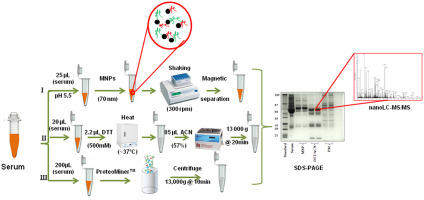Our official English website, www.x-mol.net, welcomes your
feedback! (Note: you will need to create a separate account there.)
Depleting high-abundant and enriching low-abundant proteins in human serum: An evaluation of sample preparation methods using magnetic nanoparticle, chemical depletion and immunoaffinity techniques
Talanta ( IF 5.6 ) Pub Date : 2017-04-13 14:12:53 Jemmyson Romário de Jesus, Rafael da Silva Fernandes, Gustavo de Souza Pessôa, Ivo Milton Raimundo, Marco Aurélio Zezzi Arruda
Talanta ( IF 5.6 ) Pub Date : 2017-04-13 14:12:53 Jemmyson Romário de Jesus, Rafael da Silva Fernandes, Gustavo de Souza Pessôa, Ivo Milton Raimundo, Marco Aurélio Zezzi Arruda

|
The efficiency of three different depletion methods to remove the most abundant proteins, enriching those human serum proteins with low abundance is checked to make more efficient the search and discovery of biomarkers. These methods utilize magnetic nanoparticles (MNPs), chemical reagents (sequential application of dithiothreitol and acetonitrile, DTT/ACN), and commercial apparatus based on immunoaffinity (ProteoMiner, PM). The comparison between methods shows significant removal of abundant protein, remaining in the supernatant at concentrations of 4.6±0.2, 3.6±0.1, and 3.3±0.2µgµL−1 (n=3) for MNPs, DTT/ACN and PM respectively, from a total protein content of 54µgµL−1. Using GeLC-MS/MS analysis, MNPs depletion shows good efficiency in removing high molecular weight proteins (>80kDa). Due to the synergic effect between the reagents DTT and ACN, DTT/ACN-based depletion offers good performance in the depletion of thiol-rich proteins, such as albumin and transferrin (DTT action), as well as of high molecular weight proteins (ACN action). Furthermore, PM equalization confirms its efficiency in concentrating low-abundant proteins, decreasing the dynamic range of protein levels in human serum. Direct comparison between the treatments reveals 72 proteins identified when using MNP depletion (43 of them exclusively by this method), but only 20 proteins using DTT/ACN (seven exclusively by this method). Additionally, after PM treatment 30 proteins were identified, seven exclusively by this method. Thus, MNPs and DTT/ACN depletion can be simple, quick, cheap, and robust alternatives for immunochemistry-based protein depletion, providing a potential strategy in the search for disease biomarkers.
中文翻译:

消耗人类血清中的高丰度和低丰度蛋白质:使用磁性纳米粒子,化学耗竭和免疫亲和技术评估样品制备方法
检查了三种不同的耗竭方法去除最丰富的蛋白质,以低丰度富集那些人血清蛋白质的效率,从而使生物标记的搜索和发现更加有效。这些方法利用了磁性纳米颗粒(MNP),化学试剂(二硫苏糖醇和乙腈的顺序应用,DTT / ACN)以及基于免疫亲和力的商用仪器(ProteoMiner,PM)。两种方法之间的比较表明,MNP ,DTT / ACN和PM分别以4.6±0.2、3.6±0.1和3.3±0.2µgµL -1(n = 3)的浓度显着去除了残留在上清液中的丰富蛋白质。总蛋白质含量为54µgµL -1。使用GeLC-MS / MS分析,MNP消耗显示出去除高分子量蛋白(> 80kDa)的良好效率。由于DTT和ACN试剂之间的协同作用,基于DTT / ACN的消耗在富含硫醇的蛋白(例如白蛋白和转铁蛋白)(DTT活性)以及高分子量蛋白(ACN)的消耗中提供了良好的性能。行动)。此外,PM均衡证实了其浓缩低丰度蛋白质的效率,从而降低了人血清中蛋白质水平的动态范围。处理之间的直接比较显示,使用MNP耗竭时可鉴定出72种蛋白(其中43种仅通过此方法),而使用DTT / ACN仅有20种蛋白(仅通过此方法七种)。此外,在PM处理后,鉴定出30种蛋白质,其中7种仅通过这种方法。因此,
更新日期:2017-04-14
中文翻译:

消耗人类血清中的高丰度和低丰度蛋白质:使用磁性纳米粒子,化学耗竭和免疫亲和技术评估样品制备方法
检查了三种不同的耗竭方法去除最丰富的蛋白质,以低丰度富集那些人血清蛋白质的效率,从而使生物标记的搜索和发现更加有效。这些方法利用了磁性纳米颗粒(MNP),化学试剂(二硫苏糖醇和乙腈的顺序应用,DTT / ACN)以及基于免疫亲和力的商用仪器(ProteoMiner,PM)。两种方法之间的比较表明,MNP ,DTT / ACN和PM分别以4.6±0.2、3.6±0.1和3.3±0.2µgµL -1(n = 3)的浓度显着去除了残留在上清液中的丰富蛋白质。总蛋白质含量为54µgµL -1。使用GeLC-MS / MS分析,MNP消耗显示出去除高分子量蛋白(> 80kDa)的良好效率。由于DTT和ACN试剂之间的协同作用,基于DTT / ACN的消耗在富含硫醇的蛋白(例如白蛋白和转铁蛋白)(DTT活性)以及高分子量蛋白(ACN)的消耗中提供了良好的性能。行动)。此外,PM均衡证实了其浓缩低丰度蛋白质的效率,从而降低了人血清中蛋白质水平的动态范围。处理之间的直接比较显示,使用MNP耗竭时可鉴定出72种蛋白(其中43种仅通过此方法),而使用DTT / ACN仅有20种蛋白(仅通过此方法七种)。此外,在PM处理后,鉴定出30种蛋白质,其中7种仅通过这种方法。因此,






























 京公网安备 11010802027423号
京公网安备 11010802027423号